I love Stanley Kubrick but I hate his movies. Yes, hate is a bit strong. Let’s say dislike. I just find his films boring. At the same time, I find them visually brilliant and fascinating. I can’t think of any other director that leaves me with such a conflicted response.
Who was Lawrence of Arabia?
Lawrence of Arabia is the Icarus myth. A hero starts out at neither the bottom nor top but somewhere around the middle, perhaps a bit lower than that, then ascends. But he gets too close to the sun and falls. The movie looks at that, asks why and suggests the answer is the usual thing: hubris.
Can a film noir be too perfectly noir?
I think I’m one of the few people who doesn’t care much for Out of the Past. It may be that for me the closer a movie gets to film noir, the less it appeals to me. I can’t argue with any of the superlatives used to describe this one. But despite all it does right in terms of noir, I can’t get terribly enthused.
Crawford and Gable and the oddball Strange Cargo
I stumbled upon Strange Cargo last night and rarely has the word “strange” in a title been used so appropriately. This movie is strange indeed. It’s also a pretty good adventure film starring Joan Crawford and Clark Gable (the latter’s previous movie was Gone With the Wind).
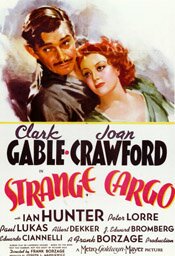 Strange Cargo (1940)
Strange Cargo (1940)
Directed by Frank Borzage
Crawford and Gable are two feisty lovers with a stormy relationship. Neither is a person of outstanding character. The storminess was likely easy for both to convey because in reality the pair, who had a prior relationship, detested one another.
In the movie, Crawford is essentially a hooker (though Hollywood censorship of the period means this is only vaguely suggested). Gable is a nasty, self-centered rogue who manages to be charming at the same time.
We find them on Devil’s Island (French Guiana) where they get mixed up with a group of convicts in an escape attempt. The majority of the movie is the struggles and conflicts of this rag tag bunch as they make their way through the jungle and swamps of the island and then on board a small ship as they try to get away.
Fine enough, and a pretty de rigueur setting for an adventure of the period. But there is an element in the movie that makes it anything but de rigueur. That element is the character of Cambreau, played by Ian Hunter. He appears mysteriously and joins the convicts in their escape but he is not your usual prisoner.
Cambreau is a Christ-like figure that steers the movie into religious allegory and allows the film to meditate on subjects like God, morality, ethics and honour. While this may not sound appealing (and yes, occasionally it is a little heavy-handed), the mysterious quality Hunter’s Cambreau figure brings adds to the adventure.
Gable, by the way, objected to this aspect of the movie. He thought it would prompt audiences to stay away. In his opinion, people expected love and sex in a Crawford-Gable movie.
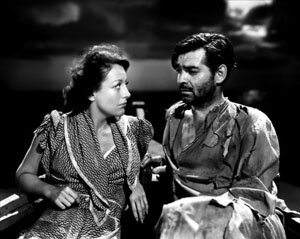
Both Crawford and Gable are wonderful in the movie, particularly Crawford as the slatternly Julie. I read somewhere that Crawford was quite proud of the way she put her “star” image aside and portrayed the character. I noticed how in many scenes she adds small, subtle touches to communicate the character’s “low rent” status, such as one scene where it is in how she sits (not what my mother would have called “lady-like”.)
She also went without makeup or false eyelashes and her costume, essentially two dresses, was from a bargain boutique.
Gable is equally unglamorous in his appearance, wearing torn clothes and growing increasingly unshaven as the movie progresses. In fact, the movie appears to make a concerted effort to ensure both its stars are unstar-like, visually.
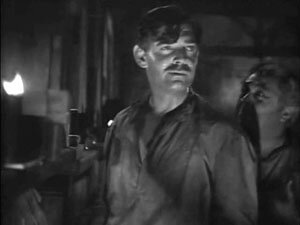
The end result is a movie that is peculiar yet compelling, partly due to its oddness. The Cambreau character, while bringing in the religious element, also adds mystery to the overall adventure as no one ever quite knows who he is.
On the other hand, some scenes aren’t subtle in communicating the Christ figure aspect, such as the scene near the end when Cambreau is in the stormy waters with his arms out, as if on a cross.
Yes, Strange Cargo is an odd movie. But it’s worth seeing at least once, especially if you’re a Gable or Crawford fan.
An aside … According to Warren Harris in Clark Gable: A Biography, this movie was made at a time when “Joan Crawford, whose box-office popularity had sunk an all-time low, had talked L.B. Mayer into teaming them (Gable and Crawford) for the first time since the 1936 Love On the Run, which was also Crawford’s last hit.”
Characters in close quarters – Crimson Tide
You wouldn’t immediately associate submarine movies with a film like Key Largo but they have something in common. The dramatic tension comes about by having characters constrained within close quarters. In Key Largo, it’s within a hotel because of a hurricane; in submarine movies it’s due to the nature of submarines.
I don’t like a phrase like “submarine movies” but there is no getting around the fact there is a kind of sub-category of action-adventure films characterized by where they are set — on submarines. They’re often among the best of the action-adventure variety of films because of the close quarters that seem to force filmmakers to concentrate on characters.
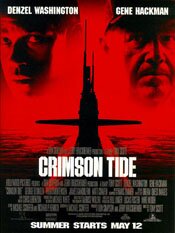 Crimson Tide (1995)
Crimson Tide (1995)
Directed by Tony Scott
In the tradition of movies like Run Silent, Run Deep, The Hunt for Red October and Das Boot, the Tony Scott directed Crimson Tide is submarine drama with strong lead characters. If it distinguishes itself from those previous movies it is by being faster moving and much noisier.
That may not sound overly appealing but it be would wrong to think that way. This is a very good, very engaging action-adventure with a strong foundation: the performances of Denzel Washington and Gene Hackman.
It’s also supported by strong performances by its supporting cast – Matt Craven, George Dzundza, Viggo Mortensen and James Gandolfini, to name a few.
Without its strong cast, I think this would likely be just an average film but with them it is firmly anchored.
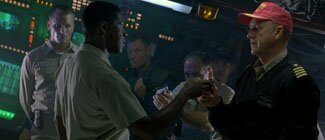
There is a state civil war in Russia. Rebel generals have taken over a base with nuclear weapons and it appears as if they may use them. The U.S. naval sub Alabama, nuclear-armed, is sent to Asian waters to await instructions. They get them: prepare your missiles. A further message, only partially received, may be orders to fire them or to stand down. It is unclear.
The movie’s conflict is between the sub’s captain (Gene Hackman) and its new executive officer (Denzel Washington). For the missiles to be fired, the two must be in agreement. They aren’t. The captain wants to fire; his second in command does not.

What makes movies like this dramatic and appealing (and you see this in films like Run Silent and Red October) is that the “bad guy” is external – off set. The leads, in this case Hackman and Washington, are both good guys but they are at opposing ends about what to do and thus in conflict.
This increases the film’s conflict by removing the easy, black and white choice and while an audiences’ sympathy may align with one, they can’t easily dismiss the other.
This is also reflected in the unfolding of the film’s drama where the sub’s crew must choose sides, many of whom are conflicted (like Mortensen’s Lt. Ince). We end up with struggles in the submarine, including mutiny, because of the lack of clarity. It’s all due to the ambiguity of the last orders received.
The movie doesn’t ease its audience into the story; it throws them in head first. Music and editing thrum as it begins with a journalist describing events in Russia. There is no slow unfolding of exposition. Director Scott and producer Jerry Bruckheimer take the approach of throwing the audience in at full speed. Details fly by like rapid fire flash cards.
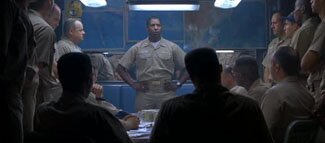
In some movies, this is noise and fury approach can be a gimmick to mask an uninspired story but in Crimson Tide it’s a quick and effective way to get quickly to what is an intelligent, well told story. Perhaps its due to the close quarters of submarines, but movies like this seem to lend themselves to dramatic, character-driven films.
While my own preference is for the quieter tension of a movie like The Hunt for Red October (which I find more effective), it works for Crimson Tide as it delivers a compelling film that leaves an audience with something to question and discuss when is over.
On the whole, this is a very good movie and well worth seeing and more than once.
And now a Capra comedy
Last night TCM ran Frank Capra’s You Can’t Take It With You and while I had the same response as what follows below — this is a very chaotic and cacophonous movie — this time I adapted to it better and noticed just how good Edward Arnold is in it. Though an ensemble piece, this is really his movie.
Capra is the kind of director people either really love or really hate. I lean more to the former but I do understand the feelings of the latter. He can be a bit much with his moralizing and sentimentality. In this case, it wasn’t those elements I found off-putting. It was the bedlam.
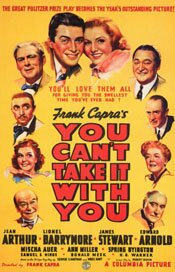 You Can’t Take It With You (1938)
You Can’t Take It With You (1938)
Directed by Frank Capra
Sometimes you can have all the right elements but they somehow don’t quite gel. This is the case with Frank Capra’s 1938 You Can’t Take It With You.
It has all the Capra elements, has the Capra touch, and even has Capra stalwarts like Jimmy Stewart and Jean Arthur, Lionel Barrymore and Edward Arnold. But it doesn’t quite work. (This was Stewart’s first movie with Frank Capra.)
I think it’s because it tries too hard. It’s almost as if the movie senses something missing and therefore tries to mask it by pushing too much.
Jean Arthur plays the relatively level-headed member of a family of free-spirited oddballs, the Sycamores. At the head of their family is Grandpa, played by Lionel Barrymore, a man who long ago gave up the competitive rat-race most people are committed to in order to do whatever he feels like doing.
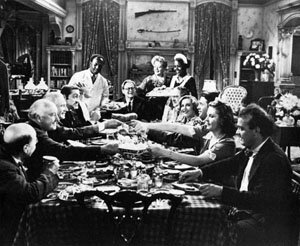 Everyone in the family follows his credo – they all do whatever makes them happy. The household is therefore chaotic – one daughter dances through the rooms, Arthur’s mother writes plays, someone’s husband makes music, while others make fireworks in the basement.
Everyone in the family follows his credo – they all do whatever makes them happy. The household is therefore chaotic – one daughter dances through the rooms, Arthur’s mother writes plays, someone’s husband makes music, while others make fireworks in the basement.
The household is wild and noisy.
Jean Arthur, the only family member who appears to actually work, meets Tony Kirby, played by Jimmy Stewart. They fall in love and want to marry. But Tony is the slightly rebellious son of parents who are straight-laced.
His father, Anthony P. Kirby (Edward Arnold) has little interest in anything other than making money. He’s the anti-thesis of the Sycamore’s Grandpa. His mother, Mrs. Anthony Kirby (Mary Forbes) is a social snob.
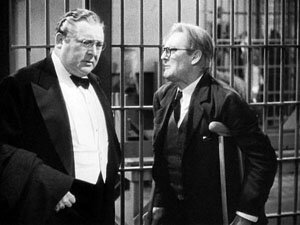 And that’s the film’s conflict and the source of its humour. The story is of how the Sycamore’s, who believe “you can’t take it with you,” win over the Kirby’s. (Well, Grandpa wins them over.)
And that’s the film’s conflict and the source of its humour. The story is of how the Sycamore’s, who believe “you can’t take it with you,” win over the Kirby’s. (Well, Grandpa wins them over.)
It’s very much a Capra theme and is played out in very Capra style.
But it doesn’t work well. The scenes in the Sycamore household are simply too excessive.
The movie tries too hard to make in chaotic and they become more annoying than amusing. The movie is also too long for the material. The main joke, the free-wheeling Sycamores, wears out quickly.
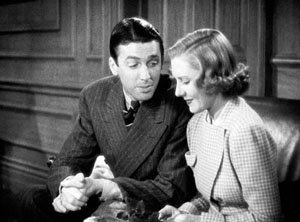 And while the lead performers are all very good, the supporting cast is a bit weak – less because of their performances than by the fact they have little to do except run around making noise.
And while the lead performers are all very good, the supporting cast is a bit weak – less because of their performances than by the fact they have little to do except run around making noise.
At best, the movie is only mildly entertaining, mildly funny. However, given the other movies Frank Capra was making around this time, he can be forgiven for having one that falls a bit flat.
And now, having said all that and having watched it again last night (February, 2011), I should point out how good Edward Arnold is in this movie. Really, the movie is all about his character. Scrooge-like (and a bit George Bailey-like), his character is the one that changes and it is his change that is at the heart of the movie. I found Arnold marvelous in this movie, very natural and also extremely funny at points (like the scene at the Sycamore’s home when he keeps sitting down in the awkward chair).
I liked the movie more this time but still feel it is a bit weak. But it’s worth it to see Edward Arnold.
Dirty Harry: should I like it as much as I do?
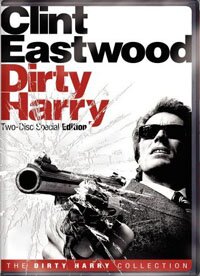 I’ve always found Dirty Harry a troubling movie. Well, almost all of the earlier, image making movies of Clint Eastwood have been troubling to me, but Dirty Harry tops my list. The reason is simple: from the first time I saw it, I’ve loved the movie but I felt that I shouldn’t.
I’ve always found Dirty Harry a troubling movie. Well, almost all of the earlier, image making movies of Clint Eastwood have been troubling to me, but Dirty Harry tops my list. The reason is simple: from the first time I saw it, I’ve loved the movie but I felt that I shouldn’t.
The conflict is easy to explain. The movie is manipulated to have you cheering for Harry so when, as in a western, the final showdown happens, there’s a cathartic moment, like scoring the winning touchdown on the last play of the game. But then you do a kind of mental double take: this guy with the big gun is actually ignoring the law, being as bad as the bad guys, and feeling justified about it because, well, they’re bad guys and he’s fighting for the good guys.
Harry is essentially a vigilante and in the movie, by creating a perverted, killing bad guy (“Scorpio”), you inevitably root for him because the emotion carries you along and your thinking side is turned off, in a manner of speaking. In his review, Roger Ebert argues that it’s essentially a fascist film, and this may be true, although I think the final scene with Harry tossing his badge in the water could be construed as meaning he’s outside the law now, no different than the criminals he’s been hunting down. It may be the movie wants you to cheer for Harry so it can then say, “Now think seriously about what you’re really cheering for.”
There are lots of people who write about Harry’s appeal to the conservative right, at least of the time (1971), and a frustration with liberal approaches to crime – respecting individual rights, in this case the criminal’s, and abandoning victims. And this may be true, too, though it should be pointed out that operating beyond the law, ignoring victims, is not something to be found on the far right of things. Some, at the far left, have had no qualms about victims when they’ve initiated a violent act for their cause. It’s an attitude that occurs at the far end of things, at extremes, be they left or right.
But what about the movie? Dirty Harry always initiates discussion about the politics of the film and often the movie itself gets overlooked.
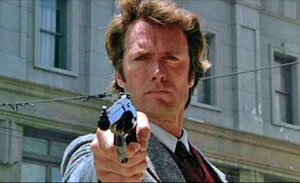 First off, I see it as an urban western, and loving westerns that may explain why I like it so much. Harry’s a loner, operating on his own (often to the exasperation of his superiors). He gets little help – some, but not a lot – and he’s after a really bad guy. So it’s framed like a moral tale, the way westerns are … but this leads us into the politics again. It is a moral tale but one a lot more subtle and ambiguous than the usual western because the good guy, well, there’s a reason they call Harry “Dirty.” (This comes up several times in the film, the question of why he’s “Dirty” Harry, with a number of possible reasons thrown out. I think that final scene with the badge is the film’s only suggestion of the real answer.)
First off, I see it as an urban western, and loving westerns that may explain why I like it so much. Harry’s a loner, operating on his own (often to the exasperation of his superiors). He gets little help – some, but not a lot – and he’s after a really bad guy. So it’s framed like a moral tale, the way westerns are … but this leads us into the politics again. It is a moral tale but one a lot more subtle and ambiguous than the usual western because the good guy, well, there’s a reason they call Harry “Dirty.” (This comes up several times in the film, the question of why he’s “Dirty” Harry, with a number of possible reasons thrown out. I think that final scene with the badge is the film’s only suggestion of the real answer.)
Another aspect I like about the movie is how very, very seventies it looks. Of course there are the clothes, the hair, the cars … but I think even more so it’s the overall look of the film. With that look, today it would be called an indie film. Despite some restoration, it still feels gritty and grainy, even when it isn’t. Not only does the movie not look slick, it almost looks anti-slick, as if it’s trying to disassociate itself from Hollywood – a characteristic of a number of movies from that period, like Taxi Driver, for instance.
I was also struck by a nice difference between Dirty Harry and its progeny, more contemporary movies with heroes and really bad villains. Today, a character like Harry would be up against an almost superhuman bad guy. But in this movie, the character of Scorpio, while very bad, is almost something of a screw up. I’m thinking of one scene where he’s out to shoot another victim but gets spotted by the police in their helicopter. Scorpio is bad, he’s dangerous, he’s sick, but he’s not a brilliant criminal mind. He’s not nearly as clever as he would like to imagine himself, and nowhere near as clever as a character such as him would be in a contemporary movie. In other words, there’s a bit more realism to Harry and his bad guy. (And realism is one of the things movies of that period aspired to.)
Finally, I believe one of the reasons this movie is so satisfying is because it understands so well set up and payoff. Like the way good jokes work, with their structure and their rhythm, there are a number of scenes in Dirty Harry that deliver the same way (for example, the “Do you feel lucky, punk?” scenes).
An interesting comparison between Dirty Harry an one of its progeny is the recent revenge film, Man on Fire, with Denzel Washington in the lead role. Whereas in Harry, directing and cinematography are almost self-effacing, with most of the emphasis on story and performance, Man on Fire is very self-consciously directed and very obvious in its cinematography, almost the exact opposite of the Don Seigal film. And whereas Harry is consumed with his hatred for bad guys and indifferent to what he does to nail them (with the possible exception of the end with the badge), Denzel’s character in Man on Fire is almost morose with awareness of being lost to the dark side and, when he goes after the bad guys, is almost like a suicide bomber, willing to do whatever needs to be done and sacrificing himself willingly as a kind of redemption. (And Denzel’s bad guy is much more clever than the Scorpio killer.)
Despite being a film from 1971 and looking very much so, Dirty Harry still works and works brilliantly. It’s just a troubling with its ambiguous politics, and just as thrilling with its cop chasing a killer suspense. I loved it.
(Note: For some of Clint Eastwood’s views on Dirty Harry, have a look at the 1974 Playboy interview, Eastwood Talks Dirty Harry. Amongst other things, when the badge scene from the movie comes up and the reference to a similar scene in High Noon, Eastwood disagees with the comparison saying High Plains Drifter is much more along the lines of the Gary Cooper film.)


